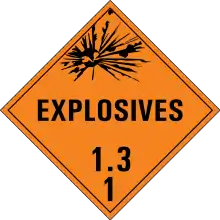Explosives shipping classification system
A matrix of the United Nations explosives shipping classification system and examples of typical materials. Each classification consists of a Sub Class Number that indicates the type of hazard and a Compatibility group suffix describing which types of product may inhabit the same means of containment.[1]
Classes
| A
Primary explosive substance |
B
Article, primary explosive, without two protective features |
C
Propellant |
D
Article, Secondary Explosive or primary explosive with two protective features |
E
Article with Secondary Explosive, not self initiating, with propelling charge |
F
Article with Secondary Explosive, self initiating |
G
Pyrotechnics |
H
Containing White Phosphorus |
J
Containing a flammable liquid or gel |
K
Containing a toxic substance |
L
Presenting a special risk requiring isolation |
N
Extremely Insensitive |
S
Packed so as to not hinder near-by firefighters | |
|---|---|---|---|---|---|---|---|---|---|---|---|---|---|
| 1.1
Mass explosion Possible |
1.1A
Mercury fulminate, Lead azide Etc. |
1.1B | 1.1C | 1.1D
Detonating cord, explosive boosters, blackpowder, most secondary explosives |
1.1E | 1.1F | 1.1G
Flash powder, Bulk Salutes, very large fireworks |
1.1J
Liquid fuelled cruise missiles and torpedoes, incendiary bombs |
|||||
| 1.2
Projection but not mass explosion |
1.2B
Detonating fuzes |
1.2C
Rocket motors, propelling charges |
1.2D
Hand grenades, shaped charges |
1.2E
Rockets with bursting charges |
1.2G
Large fireworks, practice grenades |
1.2H
White phosphorus grenades |
1.2K
Chemical shells |
1.2L
Hypergolic fuelled rocket motors |
|||||
| 1.3
Fire, minor blast |
1.3C
Smokeless powder, rocket motors |
1.3F
Fuzed hand grenades |
1.3G
Display Fireworks, smoke grenades, flares |
1.3H | 1.3L
Hypergolic fuelled rocket motors |
||||||||
| 1.4
Minor explosion hazard. |
1.4B
Blasting Caps |
1.4C
Model rocket motors |
1.4D
Det. Cord |
1.4G
Consumer Fireworks, Proximate Pyro |
1.4S
Proximate Pyro, Blasting Caps, Small Arms Ammunition | ||||||||
| 1.5
Blasting Agent, very insensitive |
1.5D
Blasting Agents |
||||||||||||
| 1.6
Explosives, extremely insensitive, no mass explosions |
1.6N |
Compatibility Groups

| Compatibility Groups | Can Be Shipped With: |
|---|---|
| A | A |
| B | B, S |
| C | C, D, E, N, S |
| D | C, D, E, N, S |
| E | C, D, E, N, S |
| F | F, S |
| G | G, S |
| H | H, S |
| J | J, S |
| K | K, S |
| L | L |
| N | C, D, E, N, S |
| S | B, C, D, E, F, G, H, J, K, N, S |
Links
- INTERNATIONAL AMMUNITION TECHNICAL GUIDELINE (IATG) 01.50, UN explosive hazard classification system and codes, Second edition, 2015-02-01
- Transport Canada, Transportation of Dangerous Goods Regulations
- Transport Canada, Statutory Instruments (Regulations) SOR/2008-34
- Australian Code for the Transport of Explosives by Road or Rail - Third Edition